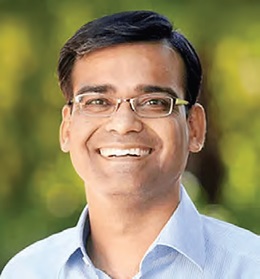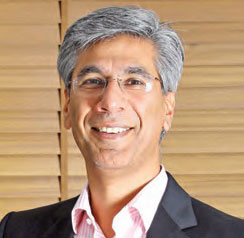UNION BUDGET 2022 Eyeing Big on Growth

The Union Budget for the next financial year beginning April 1, 2022, was presented by Finance Minister, Nirmala Sitharaman, recently. As per the Economic Survey for 2021-22, tabled in the Lok Sabha before the recent budget, India transformed from being among ‘fragile five’ nations to fourth largest forex reserve. This would be the fourth Budget presented by Nirmala Sitharaman and the second budget since Covid has emerged. Does the budget showcase India’s economic growth and progress to the world? India’s industrial sector is marred by disruptions due to the Covid-19 pandemic, will the budget provide the needed buffer against the uncertainty? As the Budget aims to kickstarting investment to boost growth, will it really help the economy out of the malaise left by the Covid-19 pandemic? Is the focus of the budget more on bolstering much needed healthcare infrastructure?
Corporate Citizen talks to business leaders and industry experts, on what were their expectations and what they wanted from the budget. How does the announced budget for the year 2022-23 affect India’s growth story going forward? Read on…

Legitimising crypto transactions in some way
We are happy to note that the FM has announced crypto tax provisions in this budget, legitimising crypto transactions in some way. However, it is disappointing to see that the Government has decided that the income from the transfer of digital assets will be taxed at 30 per cent, which seems to be too high, given that the NFTs, cryptocurrencies and digital assets space is already booming and has immense potential for the economy in the near future. I am hopeful and certain that once the full potential of crypto is realised it will be lowered further.
-OM MALVIYA,
President, Tezos India

Future-forward steps towards financial inclusion
This year’s budget has taken significant future-forward steps towards financial inclusion; the integration of post office banks, widening the scope of MSME portals and setting up digital banking are all incredible steps in extending access to finance. Moreover, the budget has also addressed the current pain points of the MSME ecosystem by extending ECLGS, with the additional allocation to be earmarked for hospitality and related industries. This provides a renewed impetus for the lending ecosystem to lend to MSMEs and empowers them. Steps taken to leverage portals like Udyam, e-shram, NCS & Aseem will go a long way in further strengthening credit facilitation and enhancing entrepreneurial opportunities for MSMEs. In terms of startups, initiatives taken towards amping up the ease of doing business in India are welcome additions to the budget. Moreover, the steps taken for existing startups like extending tax redemption and the steps taken to attract more investment into the ecosystem is encouraging for the entrepreneurial spirit of India.
-ALOK MITTAL,
Co-founder & CEO, Indifi Technologies

Focus on infrastructure to drive real estate growth sustainability
Providing a broad-spectrum booster shot to the economy, Union Budget 2022-23 is progressive-especially with its emphasis on building the infrastructure of the country. The FM clearly emphasised the top priorities of the Government-PM Gati Shakti for a sustainable growth, inclusive development, productivity enhancement, and financing of investments.
Notably, the Government also expanded the Capex target by 35.4% - from INR 5.54 lakh crore to INR 7.50 lakh crore, which may help boost overall spending towards economic growth. The budget also emphasises on the need for proper urban planning, provides some relief to states while keeping the fiscal deficit well under control. In another major positive, the Government’s aim to create six million new jobs over the next five years will enable the growth of residential real estate across the country. As anticipated, the FM also tried to rejuvenate the MSMEs sector which has a multiplier impact on the growth of the overall economy. The ECLGS scheme has been extended till March 2023 for the MSMEs. Besides providing an impetus to the industrial development, this move is likely to have a rub-off effect on the real estate sector as well given that the catastrophic impact of the pandemic on this sector (MSMEs) slowed down the demand for affordable housing in 2021. To facilitate digital inclusion and aid fund transfer, 100% of 1.5 lakh post offices will come under the complete banking system. This will enable smooth and transparent real estate transactions in the rural areas and also encourage loan disbursal to the semi-urban population.
-ANUJ PURI,
Chairman, ANAROCK Group

Pro-technology and pro-business
The Union Budget 2022-23 is a strong one that takes a future-ready strong pro-technology, pro-business and green energy stand and estimates India’s GDP to grow at about 9.2%, the highest among all great economies. The ‘One Nation, One Registration’ is a dream come true for business people, while the directive to the private sector to seek sustainable business models for battery and energy as a service is a clear step in the green energy direction. The directive to connect MSMEs such as Udyam, e-shram, NCS & Aseem portals will further widen their scope and leverage them as portals with live organic databases providing G-C, B-C & B-B services such as credit facilitation, enhancing entrepreneurial opportunities. As for agriculture, the Government is opening channels to boost chemical-free natural farming and leverage kisan drones towards crop assessment, digitisation of land records, and pesticides dissemination. The Rs.2.37-lakh crore worth of MSP direct payments set aside for wheat and paddy farmers is a much-needed aid for farmers. The ramp-up of capital expenditure by 35.40% to Rs.7.50 lakh crore and the upgrade to the credit guarantees trust for micro and small enterprises with the necessary fund injection, adding approximately an additional Rs.2 lakh crore in MSME’s bounty, are signs of the Government loosening their purse strings for the needy sector. The launch of urban sector development plans for CoEs with an outlay of 250 crores, formulation of battery swapping policy, et al. is definitive moves by the Government towards progress in every direction and across all mediums. The ‘Gati Shakti’ master plan shows a constructive plan as a remedy of the nation’s need for a world-class infrastructure, and the PLI Scheme to generate at least 60 lakh new jobs over five years is another welcome move after a couple of challenging economic years.
-MANISH AGGARWAL,
Director, Bikano, Bikanervala Foods Pvt Ltd

Steps in the right direction to empower ‘Digital India’ vision
Finance minister Nirmala Sitharaman has brought numerous measures to boost the economy with ECLGS extension and other measures in the Union Budget 2022. The Union Budget 2022 has acted as a booster shot for the MSME sector with an extension of ECLGS and an enhanced guarantee cover of Rs.50,000 crore. The proposed move will provide the much-needed credit for the recovery of small businesses and drive the economic growth of the country. We further applaud the Finance Minister for introducing an end-to-end online e-Bill System for procurements by central ministries which will bring in enhanced transparency and help in reducing the delays in payments. The initiatives proposed are steps in the right direction to empower PM Modi’s ‘Digital India’ vision.
-ARUN POOJARI,
CEO, Cashinvoice

Budget rightly aligns with our vision of democratising education estate growth sustainability
The Covid-induced gap in learning needs to be addressed on priority and EdTech platforms should continue to ensure that students receive uninterrupted learning in such challenging times. By providing students easy access to quality learning, this year’s budget lays a clear emphasis to reduce the gap between students in remote areas and education. Initiatives such as the ‘One Class One TV Channel’ and the E-Vidya scheme is a welcome move that will drive impact at scale and bridge the language divide amongst students from small-town India. We believe that this budget rightly aligns with our vision of democratising education by providing students access to high-quality learning, improving learning outcomes and thereby contributing to a vibrant knowledge economy.
-VAMSI KRISHNA,
CEO & co-founder, Vedantu

The future of the world is tech-driven
The sooner our policies align with the industry demand, the better it will be for our country’s talent pool and longterm growth. This year’s budget lays down the Government’s vision in the same direction. The digital university announced by the Hon’ble Finance Minister has the potential to make education more accessible and democratic, and bridge class divides that exist among students from Tier 1, 2 and beyond. This ensures skill and aptitude is given priority over mere pedigree and geographical advantages. Too often, in the developer world, it is seen that good talent falls by the wayside when compared to a good ‘resume’. A digital ecosystem for skilling and livelihood can, in theory, provide many with the access to learn coding and explore other technologies. Self-taught coders are on the rise, comprehensive and skilling programs aligned with the industry can improve the tech talent pool across the country, helping us stay ahead. In theory, skill assessment functionality will only add to the future-readiness of the company’s youth. In practice, it will be interesting to know how the API-based skill credentials and payment layers will function. With time, the impact and effectiveness of these actions will unfold, however, I personally will have my eyes peeled for our first self-taught, digital university-certified, tech leader.
-VISHWASTAM SHUKLA,
CTO, HackerEarth

Reshaping India into a Digital Nation
If there is one sentence in which the Union Budget can be summarised it will be a budget that puts in a laser focus on leveraging technology to make India a digital nation. Investment in futuristic technologies in all areas and the introduction of the digital rupee is a clear step towards making India more digital savvy, which is the need of the hour. One striking feature of the Union Budget is an investment of Rs.3000 crores towards reskilling and upskilling through the National Apprenticeship Promotion Scheme (NAPS). Through this investment, the Government aims to enhance the technical skills of the youth, which in turn will increase the number of industry-ready candidates for jobs. The Budget also mentioned the introduction of an e-portal for a digital ecosystem known as DESH STACK e-portal, which will help in skilling, upskilling and re-skilling, eventually playing a bigger role in empowering citizens digitally. Besides this, the portal will have crucial features like API-based skill credentials, which will help potential job seekers to find relevant jobs and entrepreneurial opportunities. Another important feature and announcement made in the Union Budget is the plan to set up the National Tele-Mental Health Programme in India. The Finance Minister mentioned that there would be as many as 23 tele-mental health centres that will be launched across India. Considering the surge in the number of cases related to mental health, depression and anxiety, especially during the pandemic era, this is a welcome move from the Government. Overall, with India’s growth trajectory estimated to be 9.2%, the highest among all economies, the investment plans and initiatives announced in the Union Budget aims to support this growth and recover fast from the scars of the deadly pandemic shadowing the world for the past two years.
-PIYUSH GHOSAL,
Head – Human Resource, Pratiti Technologies

Patient-centred initiatives will play a pivotal role
We welcome the much-deserved attention on India’s healthcare sector in the Union Budget 2022-23. We are encouraged by the Government’s renewed focus on preventive and curative health and the overall wellness and well-being of our citizens. An open platform for the National Digital Health Ecosystem, which will consist of digital registries of health providers and health facilities, unique health identity, and universal access to health facilities, will widen access to health and wellness while driving focus on preventive health. Also, to better access quality mental health counselling and care services, a National Tele Mental Health Programme has been announced that’ll further help tackle the rising number of mental health disorders in the country. These patient-centred initiatives will play a pivotal role in the success of the National Health Mission.
-K R RAGHUNATH,
Senior Chairman, Jindal Naturecure Institute

Increase in healthcare spending a welcoming change
The Union Budget 2022 has some powerful insights to it. It highlighted a significant focus towards digitisation, across sectors. This will promote digital literacy among people. The introduction of ‘One Nation, One Registration’ to facilitate the ease of living and doing business will open opportunities for a lot of aspiring entrepreneurs in India. Under this, it was even announced that 25,000 compliances have been eliminated and 1,486 union laws have also been revoked; this change will help people in their business. One of the shining highlights of the budget was its focus on people’s mental health and well-being. This, indeed, comes as a welcoming change. And it is nice to know that people’s perception of mental health is changing. The outbreak of Covid was tough on all. Some are still facing its repercussions. People’s emotional well-being has gone for a toss. Direct government participation in the telehealth space will offer great benefits to the healthcare sector. Initiatives such as the National Tele Mental Health Programme will offer increased mental health support to seniors, considering how loneliness and mental health concerns are becoming more prevalent for them.
Additionally, an open platform for the ‘National Digital Health Ecosystem’ will help Care Home facilities expand their ambit within the existing market and aid people on a wider scale. The schemes will act as the bridging force for doctors and patients, also giving care at home facilities a lot more fillip. An increase in healthcare spending, even though marginal, is a welcome step towards geriatric health.
-TARA SINGH VACHANI,
Executive Chairperson, Antara Senior Living and Managing Trustee, Max India Foundation

Growth encouraging Budget
The highlight for the real estate sector is the bounce back in demand and sales across the board for the reputed developers. On the whole, the stress in the sector has reduced and this bodes well for the industry. We have noticed a 4-5% increase in prices in the last 12 months. Customers have become more discerning and are choosing reputed developers. However, there are indeed many developers who have a lot of inventory left, and also have to service debt. That is why they are having to make the choice to sell at lower rates. Looking forward, we expect to see a robust demand for projects by reputed developers. We expect that prices will continue to firm up on the back of higher demand and increasing input costs for developers.
-ROHIT GERA,
Managing Director, Gera Developments

Help manufacturing industries to upscale and become global players
Budget 2022 is futuristic, and investment focussed. It aims to propel the longterm economic growth of the Indian economy with a clear and focus on urbanisation, logistics, sustainability and digitalisation. For the manufacturing sector, there has been an apt focus on promoting exports, encouraging investments and furthering the Make in India initiatives. The reforms laid out for customs administration and digitisation will support the Special Economic Zones and enhance the competitiveness of exports which is extremely relevant given the current disruptions in the global supply chain. The continuation and allocation of Rs.19,500 crores for the PLI scheme as well as the taxation concessions for the newly incorporated manufacturing units will further boost the sector. The Government’s Atma Nirbhar Bharat programme will help to further ensure the availability of critical raw materials for the enhanced demand envisaged in the near term. The PM Gati Shakti driven by its seven engines will enhance job creation and growth for small, mid and large-scale rubber enterprises. The increased spend on infrastructure and ports will lead to increasing demand for automobiles and rubber components for the transportation as well as material handlings sectors. The extension and enhancement of support through the Emergency Credit Line Guarantee Scheme (ECLGS) scheme and revamping the CGTMSE programme will largely benefit the non-Tyre manufacturers within the rubber industry. This, coupled with the lower corporate tax, will help in reviving and bolster the growth in the MSME rubber sector. The MSME rubber industry would be concerned about the removal of concessions for the capital goods imports and how this would impact the technological up-gradation and growth which is forecasted to happen with the massive outlay for infrastructure spending. The 68% of the defence capital procurement budget earmarked for the domestic industry will encourage startups.
-AVANTIKA MAKAR,
President-Operations & HR,Oriental Rubber Industries

Growth-oriented budget
I do appreciate that the Union Budget 2022 is growth-oriented and not welfare-oriented. Overall, a fair budget with a focus on boosting agriculture and industrial economic development—the growth engine of our country. I would say that not many welfare-oriented initiatives and support have been offered. Similarly, it is also an entrepreneurial budget, which is calling India to be a part of the growth of the country.
The budget extends a huge support to the MSME and agro-processing sectors. What I also see is the budget is missing one of the most important links—women. The budget should have the allocation for the inclusion of women, otherwise, it will never give a chance to the women to become mainstream partners and help contribute to our GDP. Some of the major challenges faced by the enterprises, more so, by women are-lack of adequate credit, capital availability and skills. To make Atma Nirbhar Bharat, all these funds along with Angel Funds should also focus on the women. Though specific mention was made about revamping the CGTMSE scheme, the Union Budget of 2022 missed out to include credit availability with quick delivery systems for grassroots levels of rural, tribal and women populations, without this allocation most support stays at the urban level only. Allocation of funds for ‘contemporary market-linked technical skills’ for women enterprise startup, needed to be specifically allocated, which is missing altogether in this budget.
To make Atma Nirbhar Bharat and to make India an Entrepreneurial Society, huge funds have been allocated for general and technical education, but there is no special allocation to inculcate entrepreneurship into the curriculum. Our socialisation pattern and education system are focusing only on jobs. Hence migration to other regions and countries is seen. To change this pattern and to develop a large number of MSMEs, the government budget should allocate special funds to develop, educate and train the students towards entrepreneurship. This requires capacity building of all education institutions (schools, colleges) focusing on the development of faculty, teachers at schools and colleges to develop students for entrepreneurial activities.
-HINA SHAH,
Founder & Director, ICECD

Nayi Disha-a budget with a long-term vision
For me, Budget 2022, is clearly a budget with a ‘long-term vision’. The central piece is focused on digitisation and the technology adoption foundation for the future. A budget for Digital India 2.0, can be labelled ‘Nayi Disha’. Digitisation drive cutting across Agri, Financial, Education and Governance spelling out a vision for the future.
Driving growth: Upgradation of technology in the rural area (5G, OFC, roadways, rail connectivity). Digital Desh, One Class One TV, Digital University are the initiatives that could bring Bharat in alignment with India and give the children in Tier 2 and 3 towns and villages access to global content.
Inclusiveness: The DBT scheme, MSP for farmers where the FM declared that the Centre will pay Rs.2.37 lakh crore towards the procurement of wheat and paddy under the MSP operation, funds to finance agriculture revolution, and supporting rural startups-this budget speaks volumes of inclusiveness.
Green energy: As the world is moving towards sustainable development, it is nice to see it focus on Battery Swapping and Electric Vehicles, making it a step towards green energy and employment creation.
Finances for investments: Increase in the capital expenditure by digitising and including post offices into core banking are steps to harness the saving potential and drive for financial inclusiveness.
-PADMANABHAN BABU,
Founder and CEO, LEXSHIP

Significant focus towards the rural economy and rural development
The Budget 2022 has rightly initiated a significant focus on the rural economy and rural development. With the introduction of Kisan drones, seems to usher a wave of technology in the agri-tech sector. In another interesting development, funds with combined capital were also announced under NABARD. We welcome the Government’s low carbon development strategy which would help unlock more job opportunities. We are also happy to see the allocation of Rs.19,500 crore for the PLI scheme to manufacture high-efficiency solar modules. Tax deduction for cooperative societies up to 15% is another welcome move. However, I’m albeit disappointed to see that no major specific announcements were made for greening the dairy farming value chain.
-VASANTH MADHAV KAMATH,
Founder & CEO, Hydrogreens Agri Solutions

Fin Min wins as both economist and politician
Union Budget 2022-23 is in my opinion investment-led, progressive and a booster shot for the economy with emphasis on building solid infrastructure in India.
Importantly, the Government has expanded its Capex target by 35.4% from `5.54 lakh crore to Rs.7.50 lakh crore, thus helping boost overall spending towards economic growth. The capital spending spree covers rural and urban areas and will impact several sectors, including housing, construction, engineering, metals, auto and technology. Also notable is the thrust on social infrastructure-education, healthcare, and housing. The extension of the ECLGS scheme is also a welcome move for MSMEs as the credit and fiscal support of `5 lakh crores will give a huge boost to this sector by encouraging new businesses to open up and will certainly generate a large number of employment opportunities in a short span of time.
The introduction of a digital rupee with blockchain technology is another excellent move. The 30% tax on digital asset transfer is a bargain. However, the wisdom is in the non-deduction on computing as losses cannot be set off on other income, which in my opinion is a wise step. Also, the TDS introduction of 1% on transfers is excellent. All in all, a great step to make digital currency a well-established form of payment and strengthen technology based on it. Overall, I am all praise and thanks for the Finance Minister’s wisdom in putting India on a high-growth trajectory despite the Covid crisis.
-DR DHANANJAY DATAR,
Chairman & MD, Al Adil Trading & Masala King Exports Trading Pvt Ltd

India remaining the best-performing economy
With India remaining the best-performing economy among the larger economies as duly highlighted by the budget, the budget has stayed the course in terms of remaining a growth-oriented one. The increase of excise on unblended fuel will also help to some extent in achieving cleaner mobility. However, the bigger picture concerning the air quality has been missed. Electric is a while away. What does the country do in the interim? Low-hanging fruits like auto LPG need to be acknowledged, bringing immediate relief to the urban air pollution. In terms of promoting cleaner mobility, while the Government’s intent to encourage battery swapping technology with an eye on galvanising electric mobility is appreciated, it remains to be seen what more is there in the fine print to promote cleaner alternative fuels. At the same time, the provision for sovereign green bonds to reduce the economy’s carbon intensity must be appreciated. Also, the encouragement of agroforestry to extend PLI schemes to manufacture solar PV modules will further help pursue a more carbon-free economic pathway for the country.
-SUYASH GUPTA,
Director General, Indian Auto LPG Coalition

Decline in the reported expenditures on women
From the standpoint of women, the quantum of gender budget as a share of total expenditure stands at 4.33 per cent in 2022-23 BE compared to 4.4 per cent 2021-22 BE. There has thus been a decline in the reported expenditures on women. The Budget speech missed mentioning MGNREGA, NRLM, Nirbhaya, PMKVY, PMMVY, and SHGs. All of these have the potential to enable and facilitate women’s unpaid work and create opportunities for women to participate in the labour force, which is currently crucial for a gender-inclusive recovery process.
The Economic Survey begins by declaring a recovery from the economic crisis caused by the pandemic. Recognising the hardships faced by the people in the last two years, the Union Budget’s main focus has been on strengthening infrastructure and attracting investments. There has been an overwhelming dependence on the digital solutions for recovery and it has been reflected even in social sectors like education, health as well as in employment generation. Given such priorities, it would have been good if there were also complimentary announcements to address the digital divide in the country based on geographies, gender and social groups. The announcements around credit facilities for MSMEs are a continuation of previous policies. There is also a major push for digital facilitation for the MSMEs and new startups. The increased allocation under the Jal Jeevan Mission and PM Gram Sadak Yojana may potentially work towards improving key social sector needs.
-DR SONA MITRA,
Principal Economist, Initiative of What Works to Advance Women and Girls in the Economy (IWWAGE), an initiate of LEAD at Krea University

A budget focused on growth
It is often believed that no news is perhaps good news, so the Union Budget 2022 was brief and focused on growth. It doesn’t have much for the common man in terms of any immediate benefits, but I believe the government’s growth plans to increase our GDP and income ultimately will benefit one and all.
So, what does this mean for you?
No change in tax rates or investments under 80C. Unfortunately, there is no change in direct tax rates; many people expected tax exemptions to be increased by raising the basic exemption limit, HRA or Rs.150000 exemption limit under Section 80c of the Income Tax Act.
Pay 30% tax on your crypto profit
As a result, now that the fog has lifted, you must pay a 30% tax on the proceeds of virtual/digital assets such as your cryptocurrency investments. We don’t know if it will be regulated or prohibited, but for the time being, you can pay taxes and enjoy your profits without fear. You should also keep in mind that, aside from the cost of acquisition, you will not be able to claim any other deductions. You will not be able to offset any losses in crypto or other digital assets against other sources of income such as salary, mutual fund or stock gains.
TDS of 1% on cryptocurrency sales subject to a threshold limit
When you sell your digital asset, a 1% tax withholding will be applied, which means that both your cryptocurrency and your overall account will be brought under the income tax radar. Overall, whenever there is income, there is taxation, so this is a rather welcome move to provide clarity on this most contentious topic by bringing it within the tax net.
India’s own digital currency
According to the Finance Minister, blockchain will be used to launch India’s own digital currency. Many people believe that it will be the same as your other cryptocurrencies. But, as I keep saying, call them crypto assets rather than currency. So, it is too early to expect our digital currency to function similarly to bitcoin, and we will have to wait and see until we have more clarity. You must understand the primary distinction between a digital currency and a cryptocurrency, because a crypto may function as a currency but a digital currency may not. Digital currencies have similar properties to other currencies but do not exist in physical form; they can be used to purchase goods and services.
Income tax returns can be updated within two years
Trust-based governance will also be reflected in your taxes, so don’t worry if you want to update your previously filed tax returns for any omissions or mistakes. To facilitate this, a new provision is announced that allows for the filing of an updated return to revise and pay appropriate taxes, which can be filed within two years of the relevant assessment year. This will avoid a lot of litigations.
Surcharge on long-term capital gains is being reduced
Because the surcharge on long-term capital gains on asset transfers is capped at 15%, a lot of high-tax payers will benefit from a 15% surcharge on long-term capital gains, down from highest 37 perc ent, previously.
-RISHABH PARAKH,
Personal Finance Strategist

Strong reliance on Digital for economic growth
It is clear that technology will be a force multiplier in the coming months. And this year’s budget reiterates the Government’s strong reliance on digital for economic growth. The announcement of a Digital University, a National Digital Health Ecosystem, 75 Digital Banking Units, e-passports, and the aspiration to ensure all villages have the same access to digital resources as urban areas indicate a blueprint for IT-driven comprehensive development. The tax exemption for startups and the introduction of a digital rupee using blockchain technology will stimulate innovation and highlight the country’s appetite for emerging technologies. I’m confident that this budget will pave the way for a digitally transformed India equipped with all the resources for sustainable development at scale.
-S DURGAPRASAD, CO-FOUNDER,
Director and Group CEO, Bahwan CyberTek Group

The budget was as expected
We didn’t anticipate the industry to take centre stage because several schemes for the FMCG sector have already been implemented in recent years. However, the mention of a rationalised strategy to improve domestic oilseed production and minimise relying on imports is welcomed. A more promising statement was the package that centres on farmers adopting appropriate fruits and vegetables and proper harvesting practices. The move will go a long way towards uplifting the food processing sector.